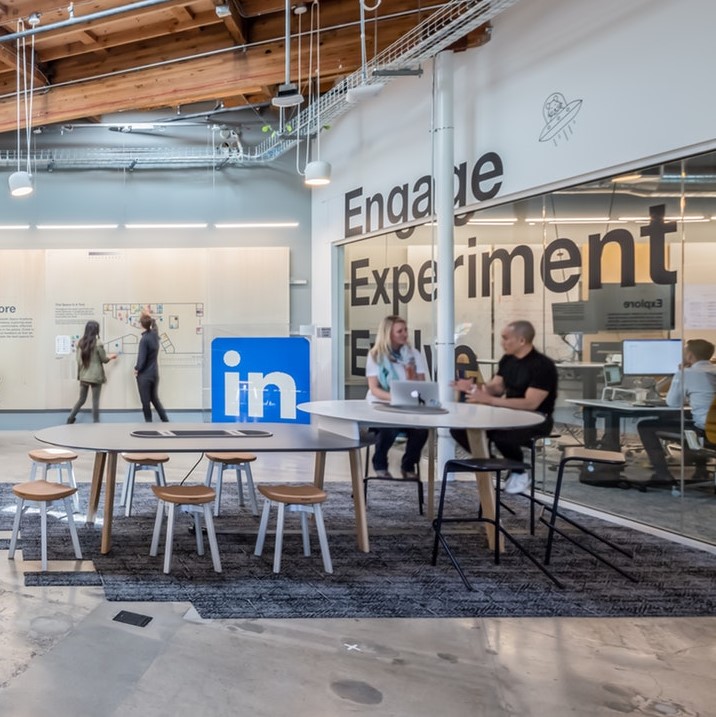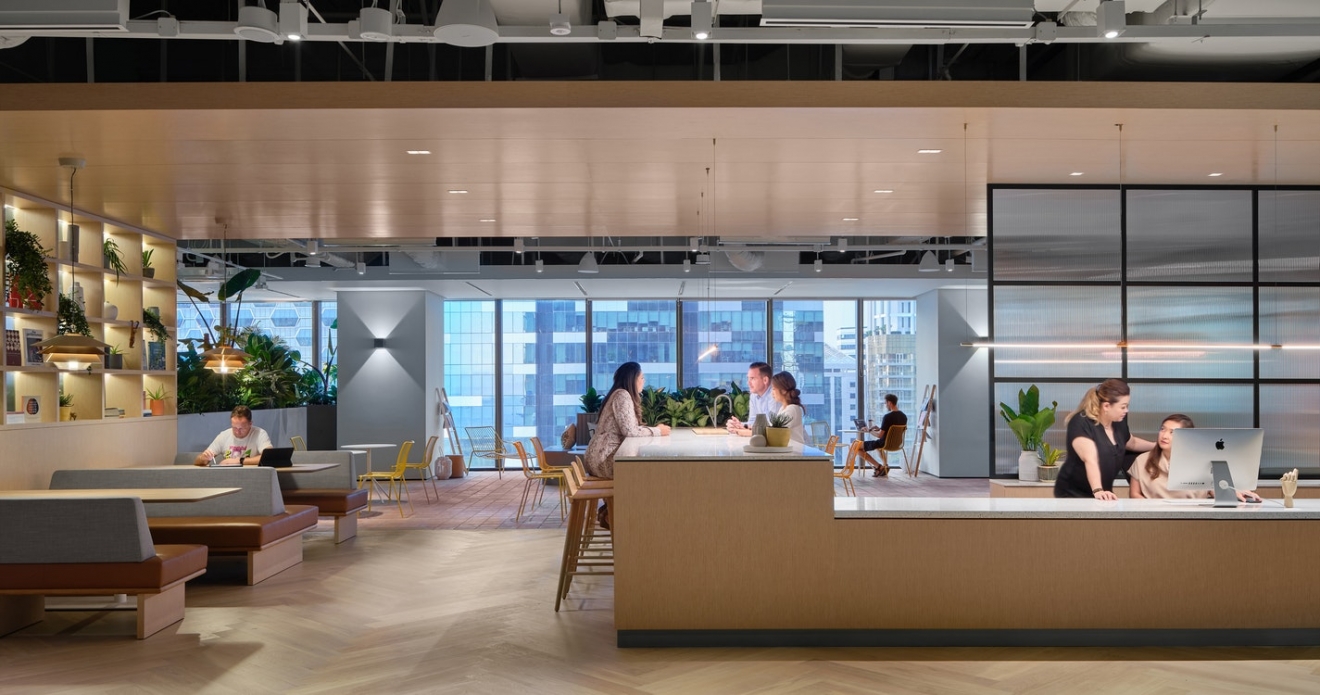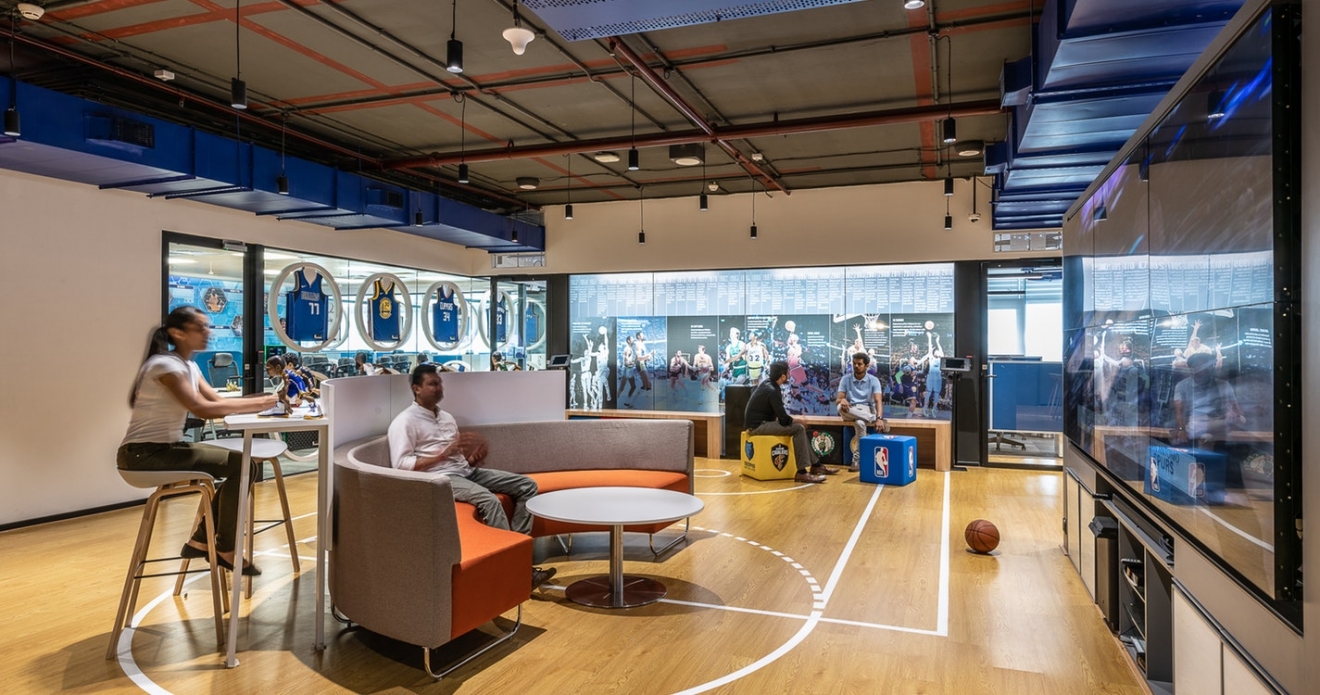 The way companies design physical environments is a direct reflection of their values and beliefs. Inequality is hardwired into the “standard” office layout, with perimeter offices and fixed desks offering limited settings for unstructured collaboration and recreation, further perpetuating the issue. Modern office design often favours extroversion and emphasises a hierarchy with values that benefit only a small portion of the overall workforce, contributing to organisation-wide imbalance. So how do we create more inclusive workplaces that can be leveraged as vehicles for change?
The way companies design physical environments is a direct reflection of their values and beliefs. Inequality is hardwired into the “standard” office layout, with perimeter offices and fixed desks offering limited settings for unstructured collaboration and recreation, further perpetuating the issue. Modern office design often favours extroversion and emphasises a hierarchy with values that benefit only a small portion of the overall workforce, contributing to organisation-wide imbalance. So how do we create more inclusive workplaces that can be leveraged as vehicles for change?
Building future-proofed work environments that value well-being, freedom of choice, and individualism for employees can help level the playing field and encourage progressive behaviour that ultimately benefits businesses. To establish a trajectory of positive, continuous change, the workspace must enable teams to push boundaries every day.
Business leaders and designers need to reassess on who workplaces are designed for, and what we want them to achieve for us – as individuals, teams and organisations. As workplace designers, we need to look beyond the challenges of today to the solutions of tomorrow to accommodate for the ongoing transformation of place, people and culture.
There are many ways that firms can go above and beyond to encompass health and equality issues, here are three areas to focus on first.
Harnessing the reason why
What gets your team out of bed in the morning? What drives them in their day-to-day routine? How are they inspired?
Understanding how culture, people and environment intersect is key to business success. There is no one route to achieving innovation in the workplace or creating the most desirable space to attract new talent. Sparked by the instantaneous gratification of an increasingly digital world, companies are often looking for the latest, quick-fix solution to their workspace challenges. What are competitors doing? What’s trending?
[perfectpullquote align=”right” bordertop=”false” cite=”” link=”” color=”” class=”” size=””]Workplaces mimic the diversity of cities where a variety of different cultures and perspectives collide[/perfectpullquote]
Businesses must switch focus to celebrate unique selling propositions and capitalise on competitive edge. If their people understand the bigger picture and what they are working to achieve, then they are empowered to drive towards a common goal. Creating purpose for people in the workplace by appealing to resolve and determination can have dramatic impact on productivity. This, in turn, benefits profitability and the ability to evolve.
By perimeter scanning and exploring internal processes, businesses can define their requirements ahead of rapid transformation. What are the needs of the future as a result of what is happening now
Functioning as dynamic melting pots, workplaces mimic the diversity of cities where a variety of different cultures and perspectives collide, stimulating innovation. However, while dense urban settings bring the benefit of access to skilled global talent, they bear the disadvantage of heightened stress coupled with strains on services – unless the design is thoroughly considered. Understanding why talent choose to work for you and how you can entice them to stay can positively inform these decisions.

Magnify the environment
The environments we inhabit directly affect our behaviour. According to a study performed at Arkin Mental Health Institute Amsterdam, those living in cities have 21 percent increased risk of anxiety disorders 39 percent increased risk of mood disorders. People density in the workplace needs to be measured and addressed to ensure physical and psychological safety.
[perfectpullquote align=”right” bordertop=”false” cite=”” link=”” color=”” class=”” size=””]Companies need to design an office environment that enables employees to choose their preferred workspace[/perfectpullquote]
Neither the corner office model nor the open floor plan is conducive to an inclusive culture. The corner office model promotes hierarchy as a value, while a fixed open floor plan seating arrangement favours extroverted employees who derive energy from social interactions. Instead, companies need to design an office environment that enables employees to choose their preferred workspace from a variety of settings and the type work to be accomplished, whether and how this involves others, and how each team member best accomplishes their work.
Such an environment should include both open areas for socialising and collaboration, as well as quiet areas for deep work and private conversations. By moving into these versatile spaces, CEOs and senior leaders provide employees direct access to communication with the organisation’s key decision-makers, regardless of their level or tenure. In turn, this access can increase day-to-day project opportunities, elevating an employee’s visibility and ultimately improving their career in the long-term.
Providing decision-makers with greater visibility and interaction with all levels of the organization unlocks new lines of communication to capitalize on innovation, purpose, direction and areas for improved efficiency. This also creates opportunities to match employee skill sets and experience with project teams’ goals, fostering cross-departmental and inter-team collaboration.
Put people first
Each employee has a unique set of needs, many of which are not always apparent. Interior designers, whose fundamental mandate is that of health, safety and well-being, have a responsibility to provide a considered and accessible workspace for all. This can range from providing wheelchair access to supporting those with hearing disabilities, colour blindness, diabetes and more.
Embracing universal office design principles and providing a plethora of options can support how people work through environmental control and freedom of choice. This enables everyone to feel and perform at their best without feeling like they have to barter for their benefits.
Another aspect of accommodating people’s individual needs in the workplace is to design for health and well-being. For example, Wellness & Parenting rooms provide a quiet place for time zone-hopping travellers to catch a nap, for parents needing space for resting or pumping, or for people to privately manage medication requirements. Sit-stand desks help fight sedentary disease, obesity, and encourage healthy work styles while offering employees the enhanced choice of personalised working for a marginal cost increase when procuring furniture. 80 percent of adults suffer from lower back pain at some point in their lives, providing small conveniences in the workplace can decrease that number.

Fostering interactions across the organization is also important in nurturing and gleaning the full impacts of diverse workforces. Incorporating centralized spaces like open cafes, reception desks and work points designed for high traffic will encourage cross-functional interactions. In addition, workplaces should incorporate inclusivity across the gender identity spectrum. This goes beyond washrooms and into the company culture where organisations have the power to incorporate inclusive design language, enabling employees to reinforce preferred pronouns, and feel safe in being their authentic self at work.
While these office design choices may seem tailored to small percentages of the workforce, they ultimately benefit all. Our health is fragile and well-being paramount, and circumstances can change overnight.
Looking to, and beyond, wellness design can be a vehicle for meaningful change because it has the power to transform offices into inclusive, equal spaces, promoting innovation to enhance productivity. In turn, spaces designed for diverse needs empower employees and the c-suite to engage in an open dialogue around change, collaboration and culture. Implementing and maintaining an inclusive culture becomes far easier when that inclusivity is built into the very fabric of the workplace design.
Images: M Moser Associates














November 22, 2019
Office design can be a vehicle for equality and change
by Jeni Durksen • Comment, Workplace design
Building future-proofed work environments that value well-being, freedom of choice, and individualism for employees can help level the playing field and encourage progressive behaviour that ultimately benefits businesses. To establish a trajectory of positive, continuous change, the workspace must enable teams to push boundaries every day.
Business leaders and designers need to reassess on who workplaces are designed for, and what we want them to achieve for us – as individuals, teams and organisations. As workplace designers, we need to look beyond the challenges of today to the solutions of tomorrow to accommodate for the ongoing transformation of place, people and culture.
There are many ways that firms can go above and beyond to encompass health and equality issues, here are three areas to focus on first.
Harnessing the reason why
What gets your team out of bed in the morning? What drives them in their day-to-day routine? How are they inspired?
Understanding how culture, people and environment intersect is key to business success. There is no one route to achieving innovation in the workplace or creating the most desirable space to attract new talent. Sparked by the instantaneous gratification of an increasingly digital world, companies are often looking for the latest, quick-fix solution to their workspace challenges. What are competitors doing? What’s trending?
[perfectpullquote align=”right” bordertop=”false” cite=”” link=”” color=”” class=”” size=””]Workplaces mimic the diversity of cities where a variety of different cultures and perspectives collide[/perfectpullquote]
Businesses must switch focus to celebrate unique selling propositions and capitalise on competitive edge. If their people understand the bigger picture and what they are working to achieve, then they are empowered to drive towards a common goal. Creating purpose for people in the workplace by appealing to resolve and determination can have dramatic impact on productivity. This, in turn, benefits profitability and the ability to evolve.
By perimeter scanning and exploring internal processes, businesses can define their requirements ahead of rapid transformation. What are the needs of the future as a result of what is happening now
Functioning as dynamic melting pots, workplaces mimic the diversity of cities where a variety of different cultures and perspectives collide, stimulating innovation. However, while dense urban settings bring the benefit of access to skilled global talent, they bear the disadvantage of heightened stress coupled with strains on services – unless the design is thoroughly considered. Understanding why talent choose to work for you and how you can entice them to stay can positively inform these decisions.
Magnify the environment
The environments we inhabit directly affect our behaviour. According to a study performed at Arkin Mental Health Institute Amsterdam, those living in cities have 21 percent increased risk of anxiety disorders 39 percent increased risk of mood disorders. People density in the workplace needs to be measured and addressed to ensure physical and psychological safety.
[perfectpullquote align=”right” bordertop=”false” cite=”” link=”” color=”” class=”” size=””]Companies need to design an office environment that enables employees to choose their preferred workspace[/perfectpullquote]
Neither the corner office model nor the open floor plan is conducive to an inclusive culture. The corner office model promotes hierarchy as a value, while a fixed open floor plan seating arrangement favours extroverted employees who derive energy from social interactions. Instead, companies need to design an office environment that enables employees to choose their preferred workspace from a variety of settings and the type work to be accomplished, whether and how this involves others, and how each team member best accomplishes their work.
Such an environment should include both open areas for socialising and collaboration, as well as quiet areas for deep work and private conversations. By moving into these versatile spaces, CEOs and senior leaders provide employees direct access to communication with the organisation’s key decision-makers, regardless of their level or tenure. In turn, this access can increase day-to-day project opportunities, elevating an employee’s visibility and ultimately improving their career in the long-term.
Providing decision-makers with greater visibility and interaction with all levels of the organization unlocks new lines of communication to capitalize on innovation, purpose, direction and areas for improved efficiency. This also creates opportunities to match employee skill sets and experience with project teams’ goals, fostering cross-departmental and inter-team collaboration.
Put people first
Each employee has a unique set of needs, many of which are not always apparent. Interior designers, whose fundamental mandate is that of health, safety and well-being, have a responsibility to provide a considered and accessible workspace for all. This can range from providing wheelchair access to supporting those with hearing disabilities, colour blindness, diabetes and more.
Embracing universal office design principles and providing a plethora of options can support how people work through environmental control and freedom of choice. This enables everyone to feel and perform at their best without feeling like they have to barter for their benefits.
Another aspect of accommodating people’s individual needs in the workplace is to design for health and well-being. For example, Wellness & Parenting rooms provide a quiet place for time zone-hopping travellers to catch a nap, for parents needing space for resting or pumping, or for people to privately manage medication requirements. Sit-stand desks help fight sedentary disease, obesity, and encourage healthy work styles while offering employees the enhanced choice of personalised working for a marginal cost increase when procuring furniture. 80 percent of adults suffer from lower back pain at some point in their lives, providing small conveniences in the workplace can decrease that number.
Fostering interactions across the organization is also important in nurturing and gleaning the full impacts of diverse workforces. Incorporating centralized spaces like open cafes, reception desks and work points designed for high traffic will encourage cross-functional interactions. In addition, workplaces should incorporate inclusivity across the gender identity spectrum. This goes beyond washrooms and into the company culture where organisations have the power to incorporate inclusive design language, enabling employees to reinforce preferred pronouns, and feel safe in being their authentic self at work.
While these office design choices may seem tailored to small percentages of the workforce, they ultimately benefit all. Our health is fragile and well-being paramount, and circumstances can change overnight.
Looking to, and beyond, wellness design can be a vehicle for meaningful change because it has the power to transform offices into inclusive, equal spaces, promoting innovation to enhance productivity. In turn, spaces designed for diverse needs empower employees and the c-suite to engage in an open dialogue around change, collaboration and culture. Implementing and maintaining an inclusive culture becomes far easier when that inclusivity is built into the very fabric of the workplace design.
Images: M Moser Associates
Jeni Durksen is a Senior Associate, Design at M Moser Associates